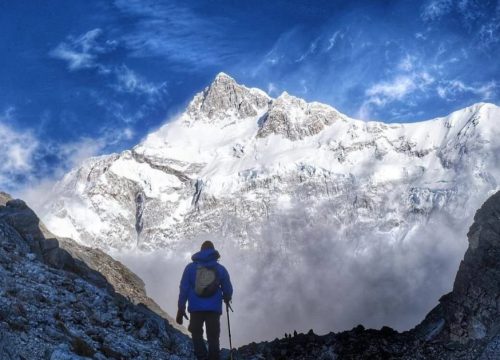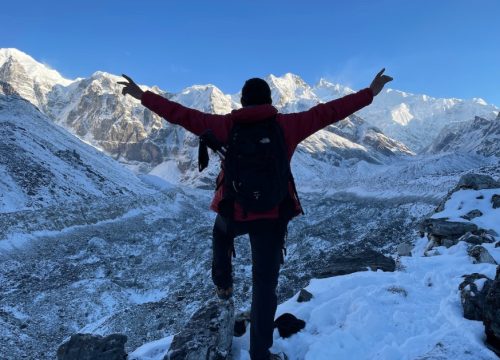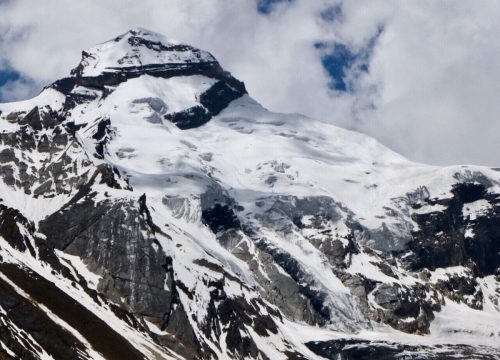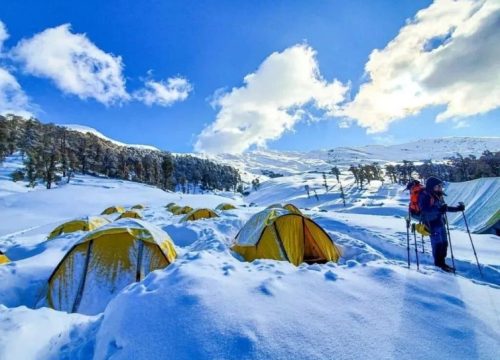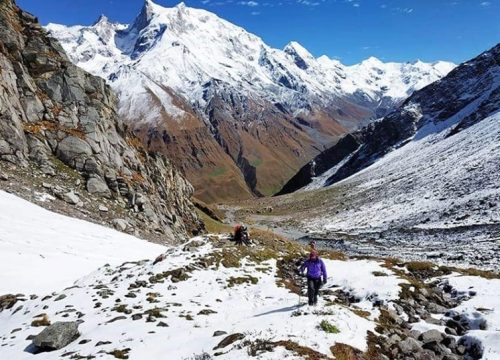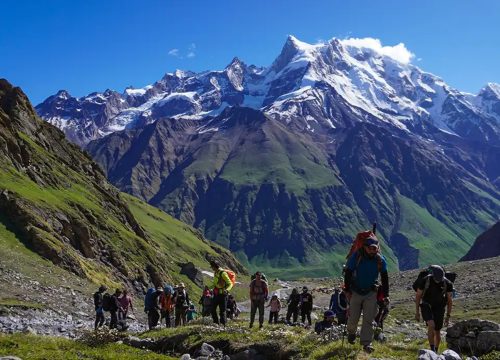Goechala Trek
Goechala Trek
The Goechala Trek is one of the most iconic and rewarding Himalayan treks in India, located in the state of Sikkim. Famous for its breathtaking views of the majestic Kanchenjunga (the third-highest mountain in the world at 8,586 m), the trek offers trekkers a chance to walk through diverse landscapes ranging from lush green forests and alpine meadows to high-altitude glacial zones. At its core, the trek is not just about reaching Goechala, but about the journey through Sikkim’s pristine wilderness, its rich biodiversity, and its unique blend of cultures.
Starting from Yuksom (1,780 m), a quaint historic town in West Sikkim, the trail meanders through ancient rhododendron forests, crossing wooden bridges, and climbing steadily past waterfalls, monasteries, and alpine valleys. Trekkers experience a constantly changing environment – from subtropical forests to snow-clad ridges. Along the way, campsites like Sachen, Tshoka, Dzongri, and Lamuney provide not just resting points but also incredible panoramic views of peaks such as Pandim, Kabru, Simvo, and the mighty Kanchenjunga itself.
How to Reach Goechala Trek
Reaching the Goechala Trek requires first getting to the base town of Yuksom in West Sikkim, which serves as the starting point of the trek. Yuksom is a historic town, known as the first capital of Sikkim, and is well connected to major cities in India via air, rail, and road. The journey to the trek involves multiple stages, combining flights, trains, and mountain roads, all offering scenic glimpses of the Eastern Himalayas along the way.
🛫 By Air
The nearest airport to Yuksom is Bagdogra Airport (IXB) in West Bengal, about 175 km away. Bagdogra is connected to major Indian cities including Delhi, Kolkata, Bangalore, and Guwahati. From Bagdogra:
Private taxi: The most convenient option. The drive to Yuksom takes approximately 6–7 hours through scenic foothills, tea estates, and winding mountain roads.
Shared cabs or buses: Available from Siliguri or Gangtok, though less frequent and slower. Many trekking groups arrange private transfers for trekkers.
🚂 By Train
The nearest railway station is New Jalpaiguri (NJP), about 160 km from Yuksom. NJP is a major rail hub connecting cities like Delhi, Kolkata, Mumbai, and Guwahati. From NJP:
Take a taxi or shared cab to Yuksom, which takes roughly 6–7 hours via Jorethang and Pelling.
Some travelers opt to first reach Gangtok by road (5–6 hours) and then continue to Yuksom (4–5 hours), though this adds travel time.
🚌 By Road
From Siliguri (165 km) or Gangtok (115 km), taxis and shared vehicles are available to Yuksom.
The road passes through Ravangla and Pelling, offering stunning views of the Kanchenjunga range, waterfalls, and terraced fields.
Expect steep, winding roads, especially after Pelling, so travel time can be longer than the distance suggests.
🏔️ Local Transfers and Trek Start
Once in Yuksom (1,780 m):
Trek preparation begins here, including gear checks, permit verification, and briefings from guides.
The first day of the trek usually starts with a short walk to Tshoka (2,200 m) or Sachen (2,500 m), depending on the trek plan.
Yuksom also offers accommodation and local supplies, including last-minute trekking essentials.
🛕 Permits and Regulations
The Goechala Trek passes through Khangchendzonga National Park, a UNESCO World Heritage Site.
Trekking requires a permit, which can be obtained at the Sikkim Tourism Office in Yuksom or arranged by registered trekking operators.
Indian trekkers must carry a valid government photo ID, while foreign nationals require passport and visa.
Guides are mandatory for the trek, ensuring safety, proper navigation, and compliance with park regulations.
🗺️ Summary of Travel Steps
Fly/Train: Reach Bagdogra Airport or New Jalpaiguri Railway Station.
Drive: Private taxi or shared cab to Yuksom (6–7 hours).
Trek Preparation: Arrange permits, gear, and acclimatization in Yuksom.
Begin Trek: Yuksom → Tshoka → Sachen → Dzongri → Goechala Viewpoint.
The journey to the Goechala Trek itself is a scenic adventure, passing through rolling foothills, tea gardens, waterfalls, and quaint towns before entering the pristine wilderness of Sikkim. Proper planning for transport and acclimatization in Yuksom is crucial to ensure a smooth and enjoyable trek experience.
Near Places To Goechala Trek
1. Yuksom (1,780 m) – Trek Starting Point
Yuksom is a historic town and the first capital of Sikkim, known for its rich Lepcha and Bhutia heritage. Before starting the trek, trekkers can explore:
Dubdi Monastery: One of Sikkim’s oldest monasteries, offering a spiritual start to your journey.
Pemayangtse Monastery: Famous for its Buddhist architecture and panoramic views of Kanchenjunga.
Local Villages: Experience traditional Sikkimese life and cuisine.
2. Pelling (2,150 m – 3 hours from Yuksom)
Pelling is a scenic hill town offering majestic views of Kanchenjunga and the surrounding valleys. Highlights include:
Pemayangtse Monastery: A serene spiritual site surrounded by pine forests.
Rabdentse Ruins: The remains of the former capital of Sikkim.
Khecheopalri Lake: A sacred lake revered by Buddhists and Hindus alike, surrounded by lush forests.
3. Ravangla (2,000 m – 2 hours from Yuksom)
A quieter town with beautiful landscapes, Ravangla is ideal for acclimatization before the trek. Key attractions:
Ralong Monastery: A colorful Tibetan Buddhist monastery.
Buddha Park: Featuring a massive Buddha statue overlooking the hills.
Nature Trails: Short hikes and forest walks in nearby rhododendron and bamboo groves.
4. Dzongri (4,030 m – Trek Route)
Dzongri is both a trek campsite and a scenic viewpoint. Though part of the Goechala Trek, it deserves special mention for its panoramic views:
Sunrise Views of Kanchenjunga: A highlight for photographers.
Alpine Meadows: Carpeted with wildflowers in spring and summer.
5. Goechala Viewpoint (4,940 m – Trek Destination)
The trek culminates here, offering a full view of the Kanchenjunga massif, along with peaks like Pandim, Kabru, Rathong, Simvo, and Talung. This is the ultimate Himalayan experience in the region.
6. Singshore Bridge & Local Villages
Located on the way to or near Yuksom, Singshore Bridge is one of the highest suspension bridges in Sikkim, surrounded by forested valleys.
Trekking or short walks to local Lepcha and Bhutia villages enrich the experience with cultural interactions, local cuisine, and handicrafts.
7. Khangchendzonga National Park
The entire trek passes through this UNESCO World Heritage Site, which itself is worth exploration:
Flora & Fauna: Red pandas, Himalayan black bears, snow leopards, and rare birds.
Conservation Trails: Educational trekking paths explaining local ecology and preservation efforts.
8. Gangtok (115 km from Yuksom)
While slightly farther, Sikkim’s capital is a cultural hub with modern amenities:
MG Marg: For shopping, local delicacies, and handicrafts.
Rumtek Monastery: One of the largest monasteries in Sikkim.
Tsomgo Lake & Baba Mandir: Accessible by a short drive for day excursions.
🌿 Why Explore Nearby Places?
Exploring these destinations complements the Goechala Trek by offering:
Acclimatization: Stops in Yuksom, Pelling, or Ravangla help trekkers adjust to altitude gradually.
Cultural Immersion: Interactions with Lepcha, Bhutia, and Nepali communities enrich the trekking experience.
Scenic Variety: From alpine meadows and forests to waterfalls and high Himalayan ridges.
Photography Opportunities: Panoramas of Kanchenjunga, sunrise/sunset views, and traditional architecture.
Other Tours
- Adi Kailash
- Aulli
- Bali Pass Trek
- Bararsar Lake
- Borasu Pass Trek
- Brahmatal Trek
- Chopta
- Dayara Bugyal Trek
- Goechala Trek
- Har Ki Dun Trek
- Haridwar
- Jungle Safari
- kausani
- Kedarkantha Trek
- Kuri Pass
- Maldaru Tal Trek
- Manali
- Munsiyari
- Nagtibba Trek
- Nainital
- Neem Karoli Baba Ashram Kainchi Dham
- Panch Kedar
- Ruinsara Lake
- Rupin Pass Trek
- Sandakphu Trek
- Valley Of Flowers Trek
Quick Links
Itinerary
Travel: Arrive at Bagdogra Airport (IXB) or New Jalpaiguri Railway Station (NJP). Drive 6–7 hours through Siliguri, Jorethang, and Pelling to reach Yuksom.
Highlights: Rolling foothills, tea estates, rivers, and terraced fields along the way.
Stay: Hotel or guesthouse in Yuksom.
Tip: Rest well for the trek; light walks around Yuksom help with acclimatization.
Trek Distance: ~8 km | Duration: 4–5 hrs.
Begin the trek with a gradual ascent through dense forests of rhododendron, oak, and bamboo.
Pass small villages and streams en route.
Stay: Campsite/tea house at Tshoka.
Highlights: Serene forest trail, local birdlife, and peaceful village interactions.
Trek Distance: ~10 km | Duration: 5–6 hrs.
Steady ascent through lush forests, crossing small wooden bridges over streams.
Stay: Campsite at Sachen.
Highlights: Remote village experience, glimpses of waterfalls, early views of snow-capped peaks.
Trek Distance: ~12 km | Duration: 6–7 hrs.
A significant ascent, moving from dense forest into alpine terrain.
Camp at Dzongri, a scenic viewpoint with panoramic views of Kanchenjunga, Pandim, Kabru, and Rathong.
Acclimatization: Take short walks around Dzongri to adapt to higher altitudes.
Distance: ~5 km | Duration: 3–4 hrs.
Optional acclimatization hike to Dzongri Top, gaining 100–150 m in elevation.
Spectacular sunrise over Kanchenjunga massif.
Return to Dzongri for overnight camp.
Highlights: Stunning photography opportunities, panoramic Himalayan views.
Trek Distance: ~12 km round-trip | Duration: 8–9 hrs.
Early morning trek to Goechala Viewpoint, the ultimate highlight, for unobstructed views of Kanchenjunga and surrounding peaks.
Return to Dzongri for overnight camp.
Highlights: Sunrise over Kanchenjunga, glacier-fed valleys, and the serene beauty of the high Himalayas.
Distance: ~5 km | Duration: 3–4 hrs.
Optional acclimatization hike to Dzongri Top, gaining 100–150 m in elevation.
Spectacular sunrise over Kanchenjunga massif.
Return to Dzongri for overnight camp.
Highlights: Stunning photography opportunities, panoramic Himalayan views.
Drive back 6–7 hours to Bagdogra Airport or NJP Railway Station.
End of trek.
Duration: 9 days
Maximum Altitude: 4,940 m (Goechala Viewpoint)
Difficulty: Moderate to Difficult (due to altitude and long walking hours)
Best Seasons:
Spring (March–May): Blooming rhododendrons and alpine flowers.
Autumn (September–November): Clear skies and unobstructed mountain views.
Accommodation: Campsites along the trail, tea houses at Tshoka and Sachen, guesthouses in Yuksom.
Book a Tour
Frequently Asked Questions for Goechala Trek
The trek is moderate to difficult due to high altitude (up to 4,940 m), long walking hours, and steep sections. Trekkers should have good fitness levels and prior trekking experience is helpful but not mandatory.
Spring (March–May): Blooming rhododendrons, alpine flowers, and pleasant weather.
Autumn (September–November): Clear skies and spectacular mountain views.
Winter (December–January): Snow-covered landscapes; very cold, requires winter gear.
Monsoon (June–August): Not recommended due to heavy rainfall, slippery trails, and leeches
Duration: 8–9 days (including Yuksom approach and return)
Distance: ~85–90 km round trip
Maximum Altitude: 4,940 m (Goechala Viewpoint)
Yuksom: Hotels or guesthouses.
Trail: Campsites at Tshoka, Sachen, Dzongri, and Goechala Base.
Meals: Tea houses at campsites serve simple, nutritious meals.
- Yes, most camps and tea houses offer vegetarian options like dal, rice, noodles, and momos. Carry energy bars and dry snacks for long trekking days.

